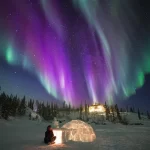Key Takeaways:
- NASA’s NEOWISE telescope has created a 12-year time-lapse movie of the entire sky by stitching together images taken every six months during its journey around the Sun.
- These time-lapse images reveal motion and changes across the celestial sphere, providing valuable insights into the universe’s dynamic nature.
- NEOWISE was originally designed to detect and study asteroids but has since become a vital tool for various astronomical studies.
- Researchers have used NEOWISE data to create catalogs like CatWISE, helping study objects like brown dwarfs and protostars.
- The telescope’s longevity has led to unexpected scientific discoveries, including insights into black holes and star formation.
NASA’s Near-Earth Object Wide Field Infrared Survey Explorer (NEOWISE) telescope has embarked on an extraordinary journey through the cosmos, capturing a mesmerizing 12-year time-lapse movie of the entire sky. The telescope, originally tasked with studying asteroids, has evolved into a critical tool for astronomers, offering a unique perspective on the ever-changing universe.
Every half-year, as NEOWISE completes its orbit around the Sun, it diligently records images in all directions. These images, when seamlessly stitched together from 18 surveys (with two more anticipated in March 2023), construct a comprehensive “all-sky” map that portrays the positions and brightness of countless celestial objects. When viewed sequentially, these maps form a cinematic depiction of the sky, unveiling transformations that span over a decade.
Astronomers find these time-lapse maps invaluable for a field known as time-domain astronomy, allowing them to identify distant objects whose positions or luminosities have altered over time. Amy Mainzer, the principal investigator for NEOWISE, emphasizes that despite appearances, the night sky is far from static. Stars flare and explode, asteroids zip by, and black holes mercilessly tear apart stars, showcasing the universe’s bustling activity.
Originally launched in 2009 as the Wide-field Infrared Survey Explorer (WISE), NEOWISE employed cryogenically cooled detectors sensitive to infrared light. Infrared radiation, invisible to the human eye, emanates from various cosmic entities, including nearby cool stars and brilliantly radiant galaxies. Although the primary WISE mission ended in 2011 due to coolant depletion, NEOWISE, along with some functional infrared detectors, was repurposed by NASA in 2013 to track asteroids and near-Earth objects (NEOs).

One notable project stemming from NEOWISE data is CatWISE, which cataloged objects based on 12 all-sky maps. Scientists use this catalog to investigate brown dwarfs, enigmatic objects abundant throughout the galaxy. Brown dwarfs, unlike stars, lack the mass to initiate fusion, yet their proximity to Earth allows them to appear as relatively fast-moving objects against the background of more distant stars. Additionally, the Backyard Worlds: Planet 9 project invites citizen scientists to comb through NEOWISE data for moving objects that automated searches may overlook.
These successive surveys have unearthed valuable insights into our cosmic neighborhood. For instance, researchers have identified approximately 200 brown dwarfs within a 65-light-year radius of the Sun, and the discovery of more Y-dwarfs, the coldest brown dwarfs, has opened intriguing questions about their formation and history. Moreover, these findings contribute to our understanding of star formation in our galaxy.
NEOWISE has also been instrumental in studying star formation. By monitoring nearly 1,000 protostars over several years, astronomers gain a deeper understanding of the early stages of stellar birth. The telescope can peer through the dusty veils surrounding these protostars, observing their fluctuations and flares as they accumulate mass from their surrounding dust clouds.
Furthermore, NEOWISE data has provided crucial insights into black holes. By utilizing a technique called echo mapping, scientists have measured the sizes of hot, glowing gas disks surrounding distant black holes, offering a glimpse into these enigmatic cosmic structures.
Peter Eisenhardt, an astronomer at NASA’s Jet Propulsion Laboratory, expressed amazement at the telescope’s longevity and the unexpected wealth of scientific data it has produced. NEOWISE continues to be a beacon of discovery in the quest to unravel the mysteries of our universe.
The mission is managed by NASA’s Jet Propulsion Laboratory and the University of Arizona, with the spacecraft built by Ball Aerospace & Technologies Corp. NEOWISE’s remarkable journey underscores the ever-evolving nature of our cosmos and the invaluable contributions of this enduring telescope to our understanding of the universe.


